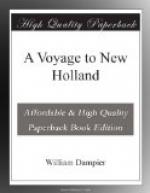Clocking-hens are much like the crab-catchers which I have described, but the legs are not altogether so long. They keep always in swampy wet places, though their claws are like land-fowls’ claws. They make a noise or cluck like our brood-hens, or dunghill-hens, when they have chickens, and for that reason they are called by the English clocking-hens. There are many of them in the Bay of Campeachy (though I omitted to speak of them there) and elsewhere in the West Indies. There are both here and there four sorts of these long-legged fowls, near akin to each other as so many sub-species of the same kind; namely crab-catchers, clocking-hens, galdens (which three are in shape and colour like herons in England, but less; the galden, the biggest of the three, the crab-catcher the smallest) and a fourth sort which are black, but shaped like the other, having long legs and short tails; these are about the bigness of crab-catchers, and feed as they do.
Currecoos are waterfowls, as big as pretty large chickens, of a bluish colour, with short legs and tail; they feed also in swampy ground and are very good meat. I have not seen of them elsewhere.
The wild ducks here are said to be of two sorts, the muscovy and the common ducks. In the wet season here are abundance of them, but in the dry time but few. Widgeon and teal also are said to be in great plenty here in the wet season.
To the southward of Bahia there are also ostriches in great plenty, though it is said they are not so large as those of Africa: they are found chiefly in the southern parts of Brazil, especially among the large savannahs near the river of Plate; and from thence further south towards the Straits of Magellan.
As for tame fowl at Bahia the chief beside their ducks are dunghill-fowls, of which they have two sorts; one sort much of the size of our cocks and hens; the other very large: and the feathers of these last are a long time coming forth: so that you see them very naked when half grown; but when they are full-grown and well feathered they appear very large fowls, as indeed they are; neither do they want for price; for they are sold at Bahia for half-a-crown or three shillings apiece, just as they are brought first to market out of the country, when they are so lean as to be scarce fit to eat.
Of their cattle, horses, etc.
The land animals here are horses, black cattle, sheep, goats, rabbits, hogs, leopards, tigers, foxes, monkeys, peccary (a sort of wild hogs called here pica) armadillo, alligators, iguanas (called quittee) lizards, serpents, toads, frogs, and a sort of amphibious creatures called by the Portuguese cachoras-de-agua, in English water-dogs.
Leopards and tigers.
The leopards and tigers of this country are said to be large and very fierce: but here on the coast they are either destroyed or driven back towards the heart of the country; and therefore are seldom found but in the borders and out-plantations, where they oftentimes do mischief. Here are three or four sorts of monkeys, of different sizes and colours. One sort is very large; and another sort is very small: these last are ugly in shape and feature and have a strong scent of musk.




